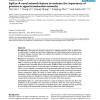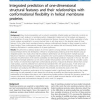199 search results - page 7 / 40 » An Intelligent System for Comparing Protein Structures |
BMCBI
2007
13 years 7 months ago
2007
Background: The simulation of metabolic networks in quantitative systems biology requires the assignment of enzymatic kinetic parameters. Experimentally determined values are ofte...
BMCBI
2006
13 years 7 months ago
2006
Background: Measuring each protein's importance in signaling networks helps to identify the crucial proteins in a cellular process, find the fragile portion of the biology sy...
BMCBI
2010
13 years 7 months ago
2010
Background: Many structural properties such as solvent accessibility, dihedral angles and helix-helix contacts can be assigned to each residue in a membrane protein. Independent s...
BMCBI
2010
13 years 7 months ago
2010
Background: Many biological functions involve various protein-protein interactions (PPIs). Elucidating such interactions is crucial for understanding general principles of cellula...
ATAL
2006
Springer
13 years 11 months ago
2006
Springer
Modeling dynamical systems composed of aggregations of primitive proteins is critical to the field of astrobiological science, which studies early evolutionary structures dealing ...




